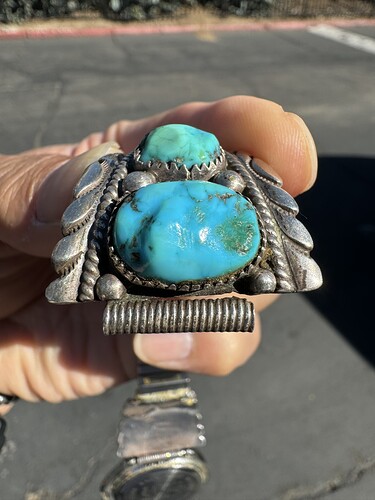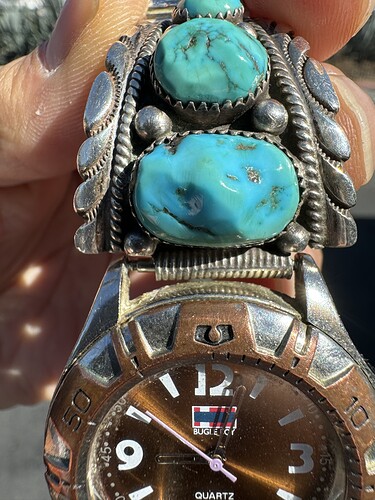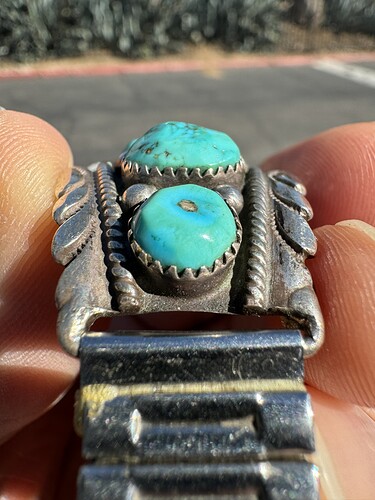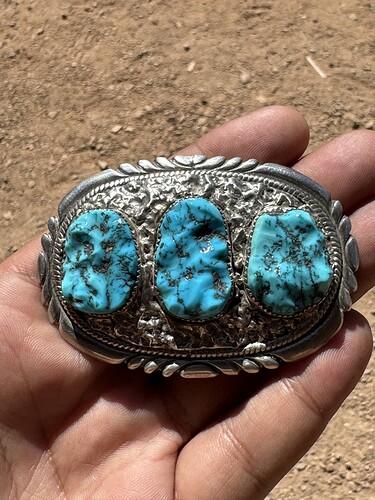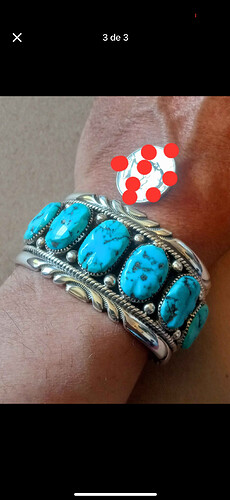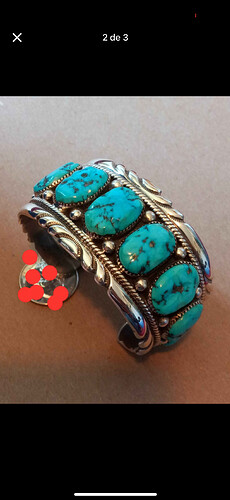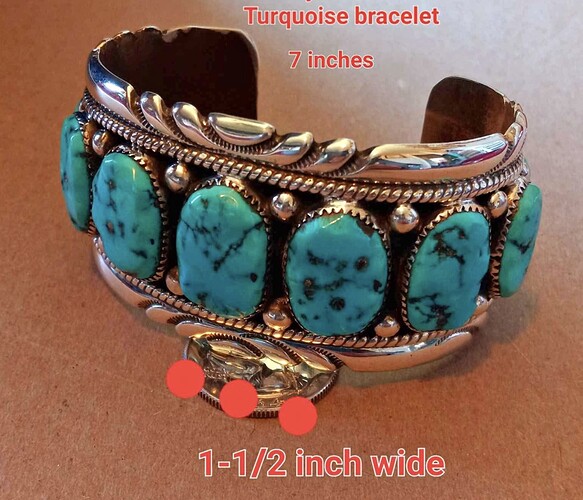Looks like it could have been made anytime from the 70s to early 2000s.
Interesting. From the side I’m not seeing a solder joint between the 1/2 round border and the back plate. Can you take a clear closeup of the side of the watch tip? I’m wondering if this is built on a cast blank. This is a fairly common procedure used in production jewelry.
I would call this a Robert & Bernice Leekya piece. I think if the piece was an imitation we would just have a different turquoise cut.
I def need to take the watch to a jeweler and have it a bit restored. Thank you so much for all of the feedback. I have more pieces I would love to inquire about
Thank you. I have to have a jeweler restore this piece a bit. I’m planning on proudly wearing this piece. I have bought so much fake turquoise in my day. I am just really wanting to know that I am wearing genuine natural turquoise. Stabilized preferred of course so that it last.
It’s a beautiful watch band. You may know this, but stabilized turquoise is real, and natural refers to unstabilized. Stabilized turquoise is not considered natural, but it is genuine. I have pieces with both natural and stabilized. I love to have the natural, but it is more money if it’s a nice stone. And natural definitely can change color over time, but I like that.
I’m thinking the turquoise in your watch band is natural, because I think I see some color change.
Thank you for the additional photos. From here it looks as if the Leekyas had the tips lost wax cast from their own handmade masters rather than hand fabricating the entire thing, and then added the bezels, fans, and shot. Smart!
It looks as if something like a very low temp Tix type solder was applied to keep the tips on the expansion band. Please advise your jeweler if any of this found its way onto the watch tips themselves, to remove this with abrasive wheels only, and not to use heat on the pieces, as the very ow temp solder can alloy with the underlying silver, and can actually melt its way through.
The stones will need to be removed for work, and anything that needs to be reattached should probably be laser welded rather heating up the whole piece to soldering temp.
Thank you very much for all of the information! So much appreciated!
I found this shop in Arizona. It’s stamped RLB. I was told the buckles has been at the shop for at least 12 years, when the current owners bought it. The turquoise seems to be natural, and not reconstituted. Thoughts?
Pretty stones. Could be natural, could be stabilized, I can’t tell, but it certainly does look like real turquoise. Natural simply means not treated in any way. Reconstituted is something completely different. Stabilized turquoise is real turquoise, just not natural. Easy to get these terms mixed up.
Welcome to Turquoise People!
Will you please post a picture of the hallmark.
The turquoise is natural Kingman, cut in Leekya’s style. The background is created by soldering on drops squashed during heating to give a nuggetty appearance. Borders are standard for the Leekya’s work but the degraded solder joint on the outside 1/2 round wire wrap is a bit suspect
I haven’t seen the Leekya’s use this type of background before, and if is their work, this is an unusual piece with this particular background…
Thank you for the information, Roger. I attached a picture of the hallmark as well.
I had never seen that background before either but it’s definitely the right signature.
That is Robert and Bernice Leekya. Their work generally fetches a good amount. ![]()
I thought it was Robert & Bernice, but that’s the first time I’ve seen that background as well.
To me it looks like this background was experimental for them (maybe the only piece they made like this?). Between the solder at the joint on the first wrap degrading from repeated heating, and micro- fractures on the back of the piece, its clear the piece was reheated to solder melting temp, and quenched numerous times during the fabrication process. This is consistent with applying this type of background treatment, and would have taken quite a bit of additional time.
Wouldn’t be surprising if they tried it out on one or more pieces, and then quickly abandoned it for a more profitable and traditional use of their bench time.
Hi guys! I’ve just found this piece and I’m definitely interested in buying it. I just want to make sure that it’s in fact an original piece! I really really appreciate your opinion and thoughts!
Hi @Mafifafi Welcome. Did you post on this thread because it has RLB as hallmark? You’ll have to show a good pic of the hallmark/stamps.
